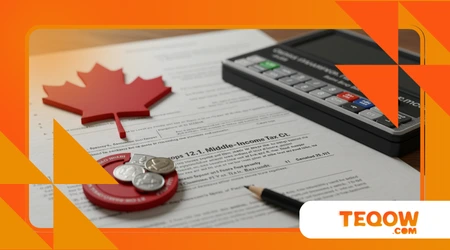Middle‑Income Tax Cut 2025: How Much You’ll Save and When

Middle-Income Tax Cut 2025 arrives as a beacon of relief for Canadians grappling with rising costs. Announced by Prime Minister Mark Carney, this policy slashes the lowest federal personal income tax rate from 15% to 14%, effective July 1, 2025.
Nearly 22 million Canadians stand to benefit, with two-income families potentially saving up to $840 annually by 2026. But what does this mean for your wallet?
When will you see the extra cash? This article dives deep, offering clarity, practical examples, and actionable insights.
From paycheque impacts to tax credit nuances, we’ll unpack the policy’s promise and pitfalls, ensuring you’re equipped to navigate this financial shift. Let’s explore how this tax cut shapes your future.
Why the Middle-Income Tax Cut 2025 Matters
Rising costs have squeezed Canadian budgets, from groceries to housing. The Middle-Income Tax Cut 2025 aims to ease that pressure.
By reducing the tax rate on the first $57,375 of taxable income, it targets middle- and low-income earners.
This move reflects a government responding to voter demands for affordability, post-election. It’s not just about savings it’s about economic stimulus, encouraging spending to fuel local businesses.
Yet, the policy isn’t without critics. Some argue it’s too modest, offering mere pennies daily for some. Others worry about its $27 billion cost over five years.
++ National School Food Program: What the $1B Investment Means for Canadian Kids
Still, for families stretched thin, every dollar counts. Imagine redirecting savings to childcare or debt repayment small wins add up.
This tax cut also signals a shift in fiscal priorities. With trade tensions looming, Canada needs resilient households.
The policy’s focus on middle-income earners aims to bolster economic stability. Will it be enough to counter inflation’s bite? That’s the question lingering for many.

How Much Will You Save?
The Middle-Income Tax Cut 2025 promises tangible savings, but the amount varies by income. For 2025, the tax rate drops to 14.5% due to the mid-year start.
In 2026, it stabilizes at 14%, maximizing benefits. A single earner making $50,000 could save $250 in 2025, rising to $500 in 2026.
For couples, the savings double. A dual-income household with each partner earning $45,000 could save $840 by 2026.
According to Finance Canada, nearly half the relief targets those earning under $57,375, ensuring broad impact. But higher earners benefit less proportionally, as only their first $57,375 qualifies for the reduced rate.
Also read: Abortion of Carbon Tax: What Mark Carney’s 2025 Move Means for Consumers
Consider Sarah, a teacher earning $55,000. She’ll save $250 in 2025, enough for a few months’ groceries. By 2026, her $500 savings could fund a family vacation. These examples show the cut’s real-world value, though modest for some.
Not everyone sees equal gains. Seniors on fixed incomes may save as little as $50 annually, per the Parliamentary Budget Officer (PBO).
Single parents might pocket $140. The policy’s progressive design ensures lower earners benefit most, but expectations must align with reality.
When Will You See the Money?
Starting July 1, 2025, the Middle-Income Tax Cut 2025 kicks in. Employers will adjust payroll deductions, reflecting the 14% rate.
If your income is subject to source deductions, expect slightly fatter paycheques by mid-July. The Canada Revenue Agency (CRA) has updated its deduction tables to ensure smooth implementation.
For those without automatic withholdings, like self-employed Canadians, savings materialize when filing 2025 tax returns in spring 2026.
This delay might frustrate some, but the refund will feel like a bonus. Planning ahead can maximize its impact think RRSP contributions or home repairs.
Read more: Inflation Relief and Sales Tax Freeze: How Canadians Benefit in Winter 2025
Timing matters for budgeting. A family saving $420 in 2025 might allocate it to back-to-school costs. By 2026, the full $840 could tackle holiday expenses. The mid-year start means 2025 savings are halved, but 2026 brings the full benefit.
Delays in employer updates could push savings to later paycheques. If your workplace lags, you’ll still reclaim the difference via your tax return.
Proactive communication with HR can ensure timely adjustments, putting money in your pocket sooner.
The Catch: Non-Refundable Tax Credits
The Middle-Income Tax Cut 2025 isn’t all rosy. Many non-refundable tax credits, like the Basic Personal Amount (BPA), are tied to the lowest tax rate.
As the rate drops from 15% to 14%, these credits lose value. For someone claiming the full BPA, this means a $150 reduction in credit value, per TurboTax estimates.
Lower-income earners, who rely heavily on credits, feel this pinch most. A caregiver claiming the Canada Caregiver Credit might see its value dip, offsetting tax savings. This unintended consequence has sparked debate about the policy’s fairness.
Picture Michael, a part-time worker earning $30,000. His tax savings of $250 are partially eroded by a $100 credit reduction.
While he’s still ahead, the net gain is slimmer than advertised. Awareness of this trade-off is crucial for financial planning.
On the flip side, the government argues the overall tax reduction outweighs credit losses for most. Nearly 22 million Canadians will see net savings, with middle-income households gaining the most. Still, those on the margins deserve attention to avoid being shortchanged.
The policy’s design keeps credit rates aligned with the lowest tax bracket, maintaining simplicity. But could targeted adjustments have softened the blow for vulnerable groups? That’s a question policymakers might revisit as feedback rolls in.
Economic Ripple Effects
Beyond personal savings, the Middle-Income Tax Cut 2025 aims to spark economic growth. By putting $27 billion back into Canadians’ pockets over five years, it encourages spending.
Families might dine out more, boosting local restaurants. Small businesses could see demand rise, creating jobs.
This stimulus comes at a critical time. With U.S. trade tariffs threatening exports, Canada needs a robust domestic economy.
The tax cut targets middle-income earners, who are most likely to spend locally, strengthening communities. It’s like tossing a pebble into a pond the ripples spread far.
However, critics warn of fiscal risks. The PBO estimates a net cost of $28 billion, factoring in credit reductions.
Could this strain public services or widen deficits? The government counters that economic growth will offset costs, but only time will tell.
Consider a small business owner like Priya, who sees increased customer spending. She hires an extra staff member, boosting local employment.
These micro-level impacts amplify the policy’s macroeconomic goals, but success hinges on execution.
The tax cut also dovetails with other measures, like GST relief on new homes. Together, they aim to address affordability holistically.
Yet, with inflation persistent, the cut’s purchasing power remains a concern for long-term impact.
Who Benefits Most?

The Middle-Income Tax Cut 2025 prioritizes those in the two lowest tax brackets taxable income under $114,750.
Nearly half the relief flows to those earning $57,375 or less, per Finance Canada. This focus aligns with the OECD’s middle-class definition: incomes between $52,875 and $141,000.
Families with dual incomes see the biggest wins. A couple earning $90,000 combined could save $840 by 2026, enough to cover a car payment. Single earners under $57,375 also gain significantly, with savings up to $420 annually.
But not all middle-class Canadians benefit equally. High earners, taxed at higher rates on income above $57,375, see limited gains. Seniors and low-income single Canadians might save as little as $50-$140, per PBO models, highlighting gaps in coverage.
Take Anita, a nurse earning $60,000. Her $420 savings in 2026 could fund her son’s hockey fees. Meanwhile, a senior on a $20,000 pension saves just $50, barely covering a utility bill. Equity remains a sticking point.
The policy’s broad reach 22 million beneficiaries ensures widespread impact. Yet, refining targeting could amplify benefits for vulnerable groups. Should future budgets adjust the formula to address these disparities?
Table: Estimated Savings by Income Level (2025-2026)
| Income Level | 2025 Savings (Individual) | 2026 Savings (Individual) | 2026 Savings (Couple) |
|---|---|---|---|
| $30,000 | $250 | $420 | $840 |
| $50,000 | $250 | $420 | $840 |
| $60,000 | $250 | $420 | $840 |
| $100,000 | $250 | $420 | $840 |
| $150,000 | $250 | $420 | $840 |
Source: Finance Canada, 2025. Note: Savings capped at $57,375 taxable income.
Practical Tips to Maximize Savings
To make the most of the Middle-Income Tax Cut 2025, plan strategically. If you’re an employee, check your July 2025 paystub for reduced withholdings. If savings don’t appear, nudge your HR department to update deductions.
Self-employed Canadians should set aside expected savings $250-$420 for tax season. Use the funds for RRSP contributions, which compound tax benefits. Alternatively, pay down high-interest debt to stretch savings further.
Budgeting is key. A family saving $840 in 2026 might allocate it to an emergency fund. Single earners could invest in upskilling, boosting future income. Small, intentional choices amplify the cut’s impact.
Consider tax software to optimize your 2025 return. Tools like TurboTax can identify additional credits, ensuring you don’t leave money on the table. Staying proactive keeps your finances ahead of the curve.
Finally, monitor policy updates. If Parliament tweaks the tax cut or credits, adjust your plans. Engaging with CRA resources or a tax advisor ensures you’re informed and empowered.
Frequently Asked Questions
Q: Will the tax cut affect my non-refundable tax credits?
A: Yes, credits like the BPA will lose value as they’re tied to the 14% rate, reducing benefits by up to $150 for some.
Q: When will self-employed Canadians see savings?
A: You’ll claim savings when filing your 2025 tax return in spring 2026, unless you adjust quarterly instalments with CRA guidance.
The Middle-Income Tax Cut 2025 offers a lifeline for Canadians navigating economic headwinds. With savings up to $840 for families, it’s a step toward affordability.
Yet, its modest scope and credit trade-offs spark debate. Is this cut bold enough to transform lives, or merely a Band-Aid on deeper issues?
By planning wisely, Canadians can maximize benefits, from paycheque boosts to tax refunds.
As we move into 2026, the policy’s success will hinge on its economic ripple effects and ability to deliver real relief. Stay informed, budget smartly, and let this tax cut work for you.
